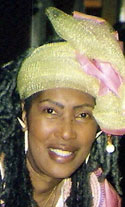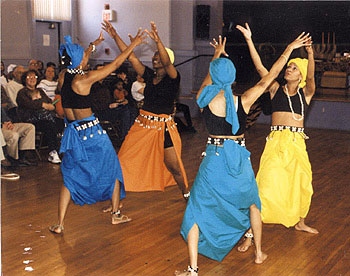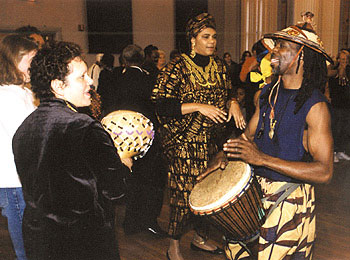Kwanzaa and Me: 2006 Marks the 40th Anniversary of Kwanzaa
 |
| by Rita Nzinga |
In 1966,Dr. Maulana Karenga decided that we as a people required a time of cultural rebirth.
In doing so, he looked to East Africa for inspiration, and developed a celebration based on numerous harvest festivals held throughout the continent.
Kwanzaa comes from the Swahili word kwanza, which means “first”, as in the phrase matunda ya kwanza (first fruits). During the harvest on the continent, everyone is welcome to the feast table. Kwanzaa at my house is celebrated by Jews, Christians, Muslims. Even some atheists are known to celebrate this holiday.
The
holiday spans seven days, beginning on December 26th and ending January
1st. Each day is marked by a principle or the Nguzo Saba, of which
there are seven. Although these principles are rooted in the
celebration, to only practice them for seven days negates the
consciousness of Kwanzaa. We should practice them daily throughout the
year.
In preparation
for Kwanzaa, there are certain items that are must haves. The mazao are
the fruits and vegetables that represent the harvest. The fruits on my
table are presented in a Senegalese close woven multi colored basket.
The mkeka is the
mat that holds the gifts of the celebration together. The mkeka also
symbolizes the foundation of the holiday. Many people adhere to the
practice that it must be a straw mat. However, I have long since
forsaken the mat for a two hundred plus-year-old piece of kuba cloth
that has been passed down through the generations of my Gambian godson,
Bangally’s family.
It is now
perfectly acceptable to use any piece of African fabric of choice.
Prior to the kuba cloth, I alternated years using both the traditional
kenté and my favorite African fabric, ashoké.
The candleholder
or kinara, symbolizes our ancestors, and should be chosen with dignity.
I currently possess two, one purchased at Goombay too many years ago to
remember, and one hand-carved by a Muslim brother that I call a friend.
Both of my kinaras are layered with multiple years of candle wax.
Photos courtesy of the YMI Cultural Center archives. |
 |
 |
The kinara has
seven branches; each one holds one of the seven mishumaa saba. The
single black candles sits in the center of the kinara — three red
candles to the left and three green candles to the right.
The muhindi are
ears of corn that represent the number of children in each household.
The corn and the children represent the continuity of our community,
and should be celebrated as such.
The kikombe cha
umoja, or the communal cup of unity, embodies the unity of all people
of African descent. The cup is used to pour tambiko, which is the
libation to the ancestors.
My cup, a
hand-carved black wooden chalice with an independent foundation, was a
gift from Dr. Kamaria Tyehimba. My cup has served me far beyond the
Kwanzaa boundaries.
I have poured
tambiko for births, deaths, marriages, birthdays and naming ceremonies.
The cup and my kuba cloth are now a part of my ancestral line, so much
so that one of my goddaughters purchased a woven African tote for them.
The zawadi, or
the gifts, are also a significant part of the harvest celebration. The
gifts may be given either daily or on a select principle. The
accentuation of selecting the zawadi should be placed on either
educational or cultural merit.
For years, my
zawadi was books. The books of course were always culturally relevant
and matched to the child. As the years have passed, especially with new
children arriving in my village, I now give photo albums. I do this
because of the fact that so much of our history, both oral and visual,
has been lost to us.
With or without
the verbiage, pictures tell their own story, and you should not be
intimidated by this concept. You don’t have to master scrap booking
101, to cover an album with a piece of African fabric and include
copies of all the pictures that you possess of a child’s family.
Habari Gani is
the question asked each day of Kwanzaa. It simply means what’s the
news, and the news is the principle of the day. It is also my personal
greeting of choice, with prayers to the ancestors that the news will
always be good.
The Nguzo Saba,
or seven principles, begins with Umoja, which means Unity. As a people
that entered this society as slaves, unity was lost to us for years, so
Umoja was the perfect choice for the first principle. We require
unification more than any other element of life on the planet.
Kujichagulia, or
self-determination, is my personal principle. As human beings, there is
little if anything that can be attained in life without
self-determination.
Ujima, or the
principle of collective work and responsibility, speaks to all that was
lost during the Theft, the Middle Passages, and Slavery. Now, we can
reclaim it!
Cooperative
Economics, or Ujamaa, speaks to the acceptance of self and community.
We as a people can and should shop within the boundaries of our
cultural commitment. I must admit that I don’t expect the average
African-American to totally grasp this principle in the manner in which
I practice it.
In my wardrobe,
you will find no Anglo-American clothing. The sisters and brothers that
have stocked my closet may neither read nor speak English, but they are
descendants of master weavers that can set the Nyame ye Ohene in the
African fabric of my choice.
Nia, or purpose,
to many is the most pronounced of the Nguzo Saba. Without purpose, how
does an individual plot the course of his or her life?
Kuumba is the
principle of creativity that embodies us as a people. For generations,
we have been blessed with the greatest scholars, authors, musicians,
politicians, athletes, and the gifts continue to reproduce themselves.
We are an awesome people!
Imani is the
principle of faith. Imani speaks our faith in God and the faith that we
have in ourselves. Faith has given us covenant with God and our
ancestors. Imani is also flourishing as a favorite name of baby girls.
For those of you
that are annual Kwanzaa celebrants, you will no doubt feel that I have
left out some significant information regarding the celebration. And
you’re right! If I were to supply all the necessary data regarding
Kwanzaa, it would surely diminish the learning process.
Kwanzaa is an
ancestral occurrence. In the forty years since its inception, people
have passed in and out of family generations. In celebrating Kwanzaa, I
pass it off to you the readers of the article as seed. In turn you may
pass to one another as blossoms, which the next generation will receive
as fruit.
Happy Kwanzaa!








